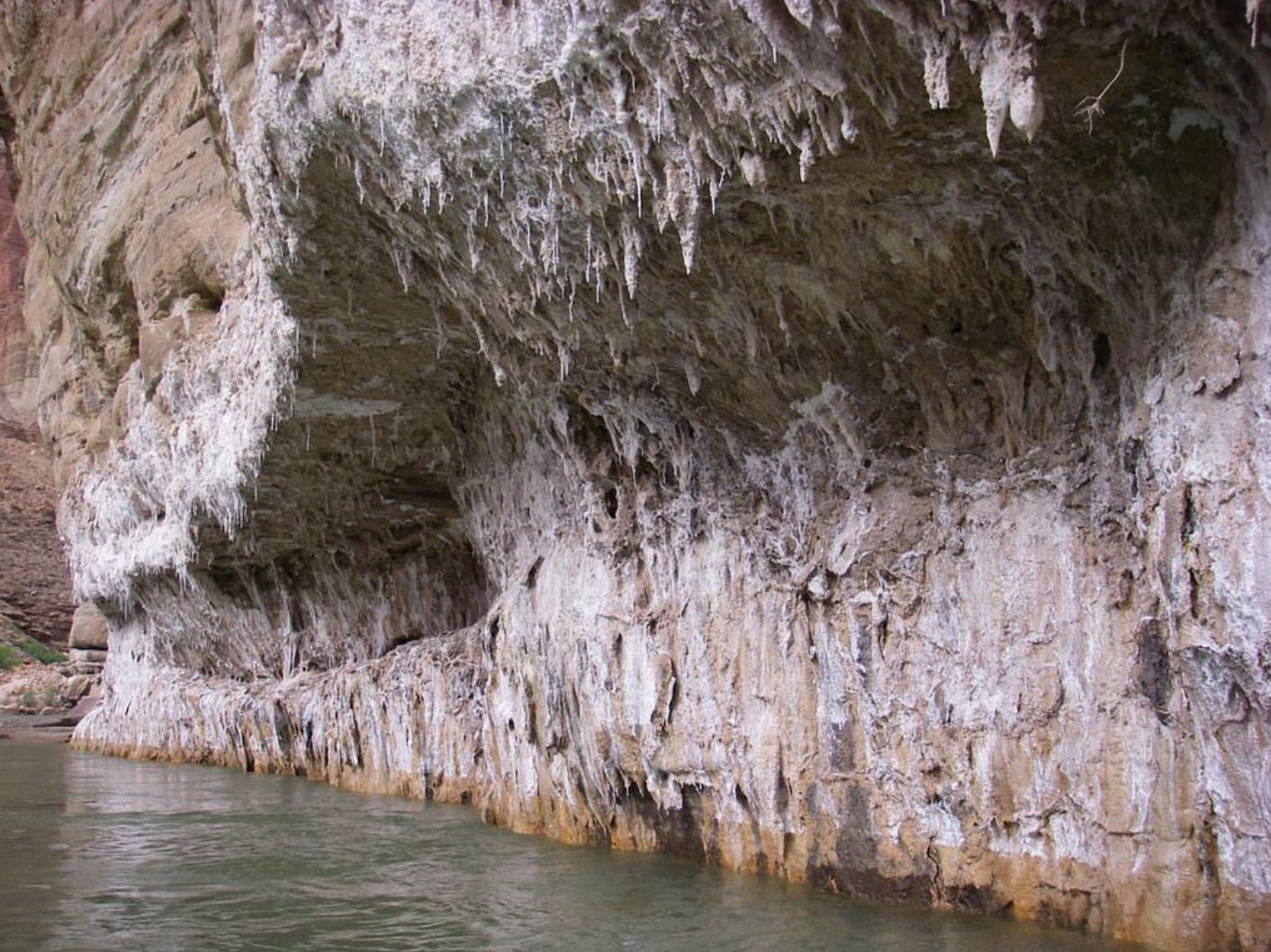Amid the red rock sandstone backdrop of the American Southwest, a Native American of the Hopi tribe gathers Tapeats salt along the Little Colorado River. This is an age-old practice that originated hundreds of years ago, long before Spanish contact, or before Manifest Destiny drove settlers west across the continent in carriages and Native American reservations were established. The white and crystalline Tapeats salt accumulates in icicle-like formations as mineral-rich water which water percolates through Tapeats sandstone, where it gets its name. The site of this collection is a cave along the Little Colorado, a tributary of the Colorado river which runs through the iconic Grand Canyon. Further downstream, people flock to the impressively deep gorge in the earth to gather on its winding 277-mile-long rim. Some float down the one-mile-deep in a raft or kayak, all the while enveloped by natural resources such as the Tapeats salt that to this day, continue to provide Native Americans like the Hopi with raw materials which which they make a livelihood. In the past decade alone, more than 40,000,000 visitors have seen and experienced the Grand Canyon[1]. Of these 40 million visitors, it is unclear how many understand and appreciate the the continued presence of native people in the park and its surrounding ecosystems, and what might be gained by learning from this rich and deeply complex Native American history.
The Hopi, Hualapai, Navajo, and Paiute are just a handful of the tribes that currently live in the American southwest. Contemporary research suggests that these groups originated from ancient Asian travelers who migrated across the Bering Land Bridge between Siberia and Alaska about 23,000 years ago, eventually splitting into the diverse ethnic and cultural groups observed in the southwest today[2]. The evidence from this hypothesis comes from genetic tests of modern-day Native Americans, specifically their maternally-inherited mitochondrial DNA, which has been linked to peoples in and originating from Siberia. As these intrepid hunter-gatherer groups settled in the southwest, they developed close ties with native vegetation, landscapes, and natural resources, often creating complex mythology and oral history which exists to this day. Some of this cultural history has survived in the form of “Salt songs,” which encode stories and information about the natural world and are passed from one generation to the next.
To a modern day American traveler, the plants in the southwest may look the same, but to the Native American tribes that inhabit this region, they are numerous and many serve multiple purposes. Prickly pear cactus fruits, Pinyon pine nuts, mesquite beans, agave, yucca, acorns, and the seeds from grasses and various herbs are foraged and consumed as food. The sap of the Pinyon pine can also be used to glue arrowheads to sticks and make baskets waterproof, and the needles can be used to make medicinal tea. Contrary to popular beliefs about Native Americans passively gathering materials, we now know that some of these plants were cultivated specifically for consumption, and heavily managed. For example, the Pinyon pine is more productive as a food crop when its lower branches are cut and when parasites such as mistletoe are removed. Native people learned this about the Pinyon pine, and in the same way a farmer might care for their crops, they became the stewards of the Pinyon pine’s health.
Plants were not only used for food. To the modern American visitor visiting the southwest, perhaps the most well-known use of plants by native people is for basket-making. Baskets are woven with multiple types of pliable natural fibers such as willow, red bud, and bracken fern, and dyed with natural ingredients. The Paiute basket shown below which depicts butterflies, birds, and plants is just one of many types of basket that have captured the imagination and wonder of modern day visitors, and it’s a cultural practice that, while weakened by the brutal history of native people, is still alive.
Learning about how an ancient cultural group used the natural world around them elicits a powerful question for American land managers and conservationists: in a post-expansionist world, what role do we play in protecting the connection of native people the environment that has been their home and livelihood for so long? Surely their needs are not the needs that we might perceive as important. In light of this ignorance, it seems only appropriate that land managers and conservationists include tribal opinions into land management decisions. Doing so protects the integrity and cultural history of native people, and enriches the experience of modern day Americans visiting these diverse and productive ecosystems. After all, what better way is there to learn about and appreciate the cultural and natural environment than through the experience of local people whose ancestors who have lived in, managed, and subsisted on these lands for millennia?



Sources:
- How many visitors to the Grand Canyon per year? (2014, May 07). Retrieved February 05, 2017, from https://grandcanyon.com/news/how-many-visitors-to-the-grand-canyon/
- Raghavan, M., Steinrücken, M., Harris, K., 2015. Genomic evidence for the Pleistocene and recent population history of Native Americans. Science (80-. ). 349.
